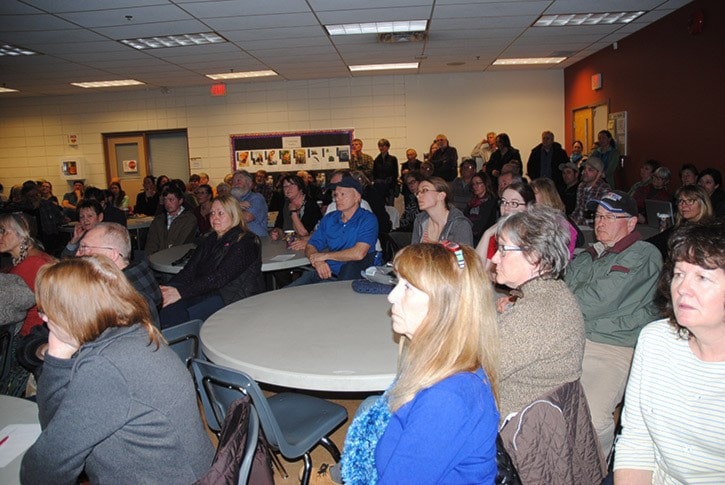About 175 people crammed into the cafeteria at Thompson Rivers University Thursday evening to learn more about Atlantic Power's proposal to upgrade its biomass-fueled electricity plant in Williams Lake to burn used railway ties.
The proposal is to add up to a 50 per cent mix of railway ties to the wood waste from the forest industry that currently fuels the plant.
But it seems that most people left the meeting with more questions than answers.
The ad hoc group of concerned citizens organizing the meeting planned a short information session from 6 to 7 p.m., Thursday, Feb. 25 but many people ended up staying on and talking about the issue in small groups for another hour and a half after that.
"I'm happy about two things," said Bette McLennan, one of the organizing committee members. "A lot of people came out and a lot of people went home stirred up about the issue."
Bruce Mack moderated the meeting.
Jim Hilton talked about research he has done on Atlantic Power's studies related to potential air quality problems associated with burning railway ties that have been treated with creosote, a known carcinogen.
Bert Groenenberg talked about the air quality monitoring systems in the city.
In their own research, Mack said the committee couldn't find any clear answers about how the project would impact the city's air quality.
The speakers encouraged people to use the avenues available to them to voice their concerns.
Information papers provided advised people to send letters of concern to authorizations.north@gov.bc.ca
They also referred people to a question and answer forum at the Atlantic Power website at www.atlanticpower.com/williams-lake.
People were also advised that they could see letters that local people had written about the proposed project by going to the website breatheasywilliamslake.org/railway-ties/.
People expressed concern about how the Ministry of Environment could make a decision on the project without more research. Some people called for a health risk assessment study to be done.
Information sheets also provided some technical information about air pollutants such as dioxin, furan, chlorophenols and various sizes of airborne particulates.
There was lots of back and forth debate over whether Atlantic Power's proposed upgrades to burn the rail ties would actually work to prevent a deterioration in the city's air quality.
Officially, Atlantic Power was not represented at the meeting, however, one employee, who said he was there for his own information and didn't wish to be identified by name, tried to answer some of the many questions people had about how the system would work. He said he trusted that Atlantic Power would meet environmental regulations.
Others said the current regulations are old and don't meet today's expectations for clean air and a healthy environment.
There were also concerns that leaching from the ash piles left by the burning of rail ties will have a detrimental impact on Williams Lake's already fragile aquifer.
There was also debate back and forth on whether the operational system proposed by Atlantic Power was the same type of system that was rejected by the communities of Kamloops and Salmon Arm.
At least three people who live near the Atlantic Power plant said they had noticed a reduction in air quality around their homes since the plant went into operation.
There were complaints about an oily residue on their vehicles periodically; waking up with sore throats; and having an oily, chemical taste in their mouths.
There were also complaints at the meeting about a noxious odour coming from the Williams Lake Atlantic Power's current woodchip pile that they said caused sore throats.
Peter Epp, who was not one of the formal presenters, made a passionate presentation about how the plant was originally supposed to be located up on a mountain away from the core community where any residue from burning would blow away from the city. He said the plant should never have been located in the Williams Lake valley which is subject to thermal inversions.
Others provided supporting comments that plants burning railway ties should only be located in rural areas well away from community settlements.
There was also debate over the economics of the proposal in relation to bringing in waste wood to burn in the plant that is now left in the bush by logging operations.
One person suggested the city should just let people have a vote on the issue.
People also wanted to know why Atlantic Power and the city didn't have representatives at the meeting and what local doctors thought about the proposal.
Mack said invitations were sent to these groups. He said Atlantic Power had agreed to make a presentation but later rescinded the offer.
Sign-up sheets were also sent around the room for people who wanted to be kept informed about future community meetings on the issue and receive information the committee may discover in its research.
